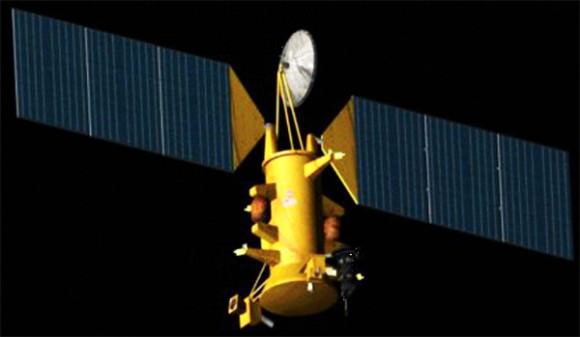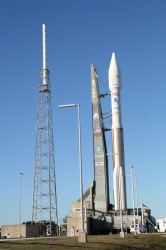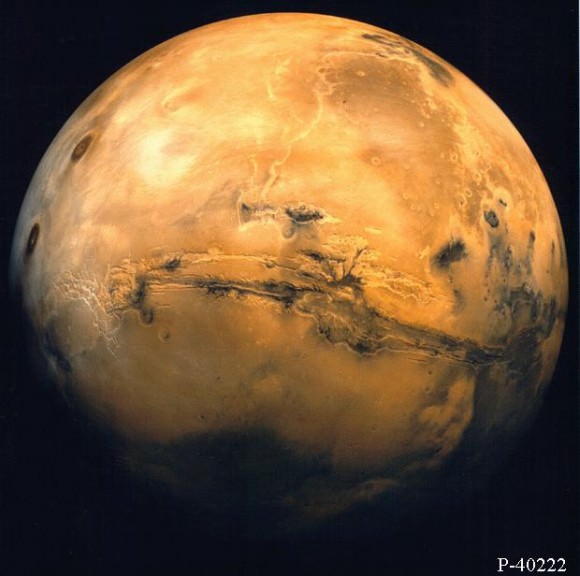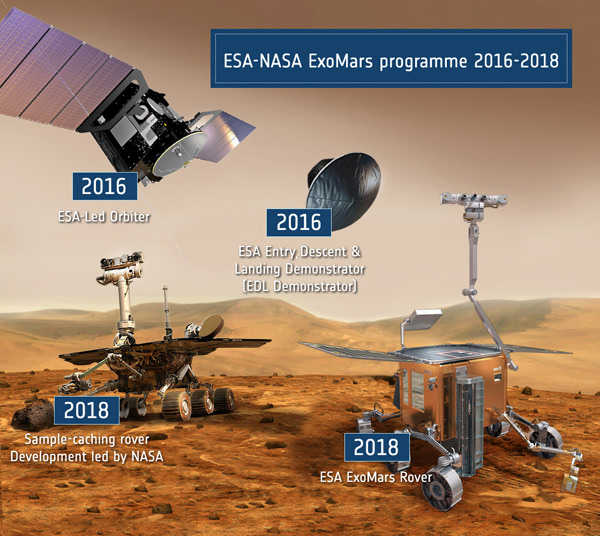[/caption]
The new joint Mars exploration program of NASA and ESA is quickly pushing forward to implement an agreed upon framework to construct an ambitious new generation of red planet orbiters and landers starting with the 2016 and 2018 launch windows.
The European-led ExoMars Trace Gas Mission Orbiter (TGM) has been selected as the first spacecraft of the joint initiative and is set to launch in January 2016 aboard a NASA supplied Atlas 5 rocket for a 9 month cruise to Mars. The purpose is to study trace gases in the martian atmosphere, in particular the sources and concentration of methane which has significant biological implications. Variable amounts of methane have been detected by a martian orbiter and ground based telescopes on earth. The orbiter will likely be accompanied by a small static lander provided by ESA and dubbed the Entry, Descent and Landing Demonstrator Module (EDM).
The NASA Mars Program is shifting its science strategy to coincide with the new joint venture with ESA and also to build upon recent discoveries from the current international fleet of martian orbiters and surface explorers Spirit, Opportunity and Phoenix (see my earlier mars mosaics). Doug McCuiston, NASA’s director of Mars Exploration at NASA HQ told me in an interview that, “NASA is progressing quickly from ‘Follow the Water’ through assessing habitability and on to a theme of ‘Seeking the Signs of Life’. Looking directly for life is probably a needle in the haystack, but the signatures of past or present life may be more wide spread through organics, methane sources, etc”.
NASA and ESA will issue an “Announcement of Opportunity for the orbiter in January 2010” soliciting proposals for a suite of science instruments according to McCuiston. “The science instruments will be competitively selected. They are open to participation by US scientists who can also serve as the Principal Investigators (PI’s)”. Proposals are due in 3 months and will be jointly evaluated by NASA and ESA. Instrument selections are targeted for announcement in July 2010 and the entire cost of the NASA funded instruments is cost capped at $100 million.

“The 2016 mission must still be formally approved by NASA after a Preliminary Design Review, which will occur either in late 2010 or early 2011. Funding until then is covered in the Mars Program’s Next Decade wedge, where all new-start missions reside until approved, or not, by the Agency”, McCuiston told me. ESA’s Council of Ministers just gave the “green light” and formally approved an initial budget of 850 million euros ($1.2 Billion) to start implementing their ExoMars program for the 2016 and 2018 missions on 17 December at ESA Headquarters in Paris, France. Another 150 million euros will be requested within two years to complete the funding requirement for both missions.
ESA has had to repeatedly delay its own ExoMars spacecraft program since it was announced several years ago due to growing complexity, insufficient budgets and technical challenges resulting in a de-scoping of the science objectives and a reduction in weight of the landed science payload. The ExoMars rover was originally scheduled to launch in 2009 and is now set for 2018 as part of the new architecture.
The Trace Gas orbiter combines elements of ESA’s earlier proposed ExoMars orbiter and NASA’s proposed Mars Science Orbiter. As currently envisioned the spacecraft will have a mass of about 1100 kg and carry a roughly 115 kg science payload, the minimum deemed necessary to accomplish its goals. The instruments must be highly sensitive in order to be capable of detecting the identity and extremely low concentration of atmospheric trace gases, characterizing the spatial and temporal variation of methane and other important species, locating the source origin of the trace gases and determining if they are caused by biologic or geologic processes. Current photochemical models cannot explain the presence of methane in the martain atmosphere nor its rapid appearance and destruction in space, time or quantity.

Among the instruments planned are a trace gas detector and mapper, a thermal infrared imager and both a wide angle camera and a high resolution stereo color camera (1 – 2 meter resolution). “All the data will be jointly shared and will comply with NASA’s policies on fully open access and posting into the Planetary Data System”, said McCuiston.
Another key objective of the orbiter will be to establish a data relay capability for all surface missions up to 2022, starting with 2016 lander and two rovers slotted for 2018. This timeframe could potentially coincide with Mars Sample Return missions, a long sought goal of many scientists.
If the budget allows, ESA plans to piggyback a small companion lander (EDM) which would test critical technologies for future missions. McCuiston informed me that, “The objective of this ESA Technology Demonstrator is validating the ability to land moderate payloads, so the landing site selection will not be science-driven. So expect something like Meridiani or Gusev—large, flat and safe. NASA will assist ESA engineering as requested, and within ITAR constraints.” EDM will use parachutes, radar and clusters of pulsing liquid propulsion thrusters to land.
“ESA plans a competitive call for instruments on their 3-4 kg payload”, McCuiston explained. “The Announcement of Opportunity will be open to US proposers as well so there may be some US PI’s. ESA wants a camera to ‘prove’ they got to the ground. Otherwise there is no significant role planned for NASA in the EDM”.
The lander would likely function as a weather station and be relatively short lived, perhaps 8 Sols or martian days, depending on the capacity of the batteries. ESA is not including a long term power source, such as from solar arrays, so the surface science will thus be limited in duration.
The orbiter and lander would separate upon arrival at Mars. The orbiter will use a series of aerobraking maneuvers to eventually settle into a 400 km high circular science orbit inclined at about 74 degrees.
The joint Mars architecture was formally agreed upon last summer at a bilateral meeting between Ed Weiler (NASA) and David Southwood (ESA) in Plymouth, UK. Weiler is NASA’s Associate Administrator for the Science Mission Directorate and Southwood is ESA’s Director of Science and Robotic Exploration. They signed an agreement creating the Mars Exploration Joint Initiative (MEJI) which essentially weds the Mars programs of NASA and ESA and delineates their respective program responsibilities and goals.
“The key to moving forward on Mars exploration is international collaboration with Europe”, Weiler said to me in an interview. “We don’t have enough money to do these missions separately. The easy things have been done and the new ones are more complex and expensive. Cost overruns on Mars Science Lab (MSL) have created budgetary problems for future mars missions”. To pay for the MSL overrun, funds have to be taken from future mars budget allocations from fiscal years 2010 to 2014.
“2016 is a logical starting point to work together. NASA can have a 2016 mission if we work with Europe but not if we work alone. We can do so much more by working together since we both have the same objectives scientifically and want to carry out the same types of mission”. Weiler and Southwood instructed their respective science teams to meet and lay out a realistic and scientifically justifiable approach. Weiler explained to me that his goal and hope was to reinstate an exciting Mars architecture with new spacecraft launching at every opportunity which occurs every 26 months and which advance the state of the art for science. “It’s very important to demonstrate a critical new technology on each succeeding mission”.
More on the 2018 mission plan and beyond in a follow up report.



WHERE are my nanobots when I need em? Sheesh..
AND what about surface penetrators for the equator to confirm and test water ice under the dust? (As seen recently with the MRO HiRise camera)
The very first picture reminds me of this very funny video:
http://www.youtube.com/watch?v=yjiGH9QNiU0
Especially note the parachute!
2016?
I really hope the current orbiters hold out that long then. I wish someone would look more seriously into financing dedicated transmission relay satellites, scattered over the solar system.
This is a would be example of out-sourcing, NASA and the ESA send the science to India to be done cheaply. Why doesn’t that french booster ever go anywhere cool? It looks big? why haven’t they put men aboard it in a little airbus STS? is their payload going to beagle?
Thanks DrFlimmer – haven’t seen this one before.
Here’s another – http://www.youtube.com/watch?v=fvg9z35-bGs, always made me laugh.
This is confusing, but by no fault of the excellent UT reporting, as the first report I read somewhere else was along the lines of ESA dropping the (weight over-run) ExoMars rover for a NASA MSL rover frame. Which presumably would account for ESA savings.
But hey, if ESA want to spend, I’m all for it! A sample return mission would be awesome even if no firm return announced yet (sample-caching is only half of it), even a 2 rover mission in and of itself.
1st, Ariane isn’t french, it’s an ESA rocket. 18 member states own and operate it.
2nd, it’s not a booster, but a launcher.
3d, it does ever go, more so than the current Atlas the article compares with; Ariane ES-ATV lifts 21 t to LEO, Atlas V 552 lifts 20 t; Ariane ECA lifts 10.5 t to GEO, Ariane V 552 a mere 8.7 t.
4th, it has gone places way cool already. It lifted XMM-Newton X-ray observer which discovered a galaxy cluster 10 Gly away; it lifted Rosetta which met asteroid 2867 and is currently on its way to asteroid 21 Lutetia, final goal is to orbit and land on comet 67P/Churyumov-Gerasimenko; it lifted ATV-1 Jules Verne to ISS; and it lifted Herschel and Planck on a dual mission to L-2 on the other side of the Moon.
[Wikipedia.]
D’oh! That is “Atlas V 551”, of course.
I should also add that despite the french name it was/is developed and produced in several nations.
Interesting to note here, the different emphasis on goals wrt Mars exploration.
US-ESA: orbital platforms and landers.
Russia-China: Missions to Phobos and orbital platforms.